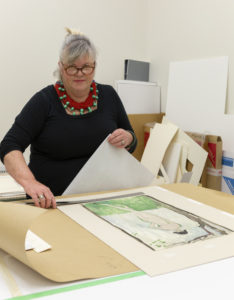01 Oct Sarjeant Gallery: Conserving Edith Collier’s work
By Helen Frances, at the Whanganui Chronicle.

Bis Beatson is working on conserving the Sarjeant Gallery’s Edith Collier collection.
Over 300 of Edith Collier’s works have undergone careful conservation work to ensure the longevity of the artist’s extensive collection held by the Sarjeant Gallery for the Edith Collier Trust.
Bis Beatson, who has worked in the arts industry for over 30 years, has concentrated on the works Collier did on paper. She sorts them into sizes then removes and replaces the old mats with new ones. The mat is the “window” that covers the edge of a two dimensional artwork. All of the works, which include pencil sketches and watercolours, are placed in paper corners to make them easy to handle without touching the painting or drawing.
“We have brought them up to conservation standard in the way they are kept. Some mats have had double-sided tape that has gone yellow and fallen apart.
“There is acid free conservation grade material sandwiched between the mat and the backing board so you can store the works very safely and put them into a frame if you want to,” Beatson said.
“The conservation materials will last for a long time without yellowing or any dangerous toxins coming off that would degrade works. Masking tape for instance has different chemicals that are not good for art works.”
Beatson says the drawings and sketches clearly reveal how Collier developed her technique and style, right from her student days through to her late career works. She has uncovered some pleasant surprises in the conservation process. Some works are double-sided and when the frames were opened up, another work or additional information has been revealed. All of the discoveries have been photographed and documented.
Some constructive criticism from an art tutor was discovered. It says: “Excellent you have thought before you put it down” and “Good work but don’t use useless half-tones”.
Sarjeant Gallery curator of collections Jennifer Taylor Moore believes the comments may be from when Collier studied at St John’s Wood School of Art in London for a two years from 1913. While in Europe, Collier was influenced by the emerging trends in modernist art – something that was not appreciated in early 20th century New Zealand.
“You can see it in the last body of work she did before leaving Europe, particularly in her work at St Ives – in the simplification of forms and the flattening of the picture frame, sometimes using blocks of colour. Because her works are held here, our Tylee residency artists have viewed them and made artistic responses to the works – for example, Annie Mackenzie, Julia Holden and Susan Frickberg have created artworks inspired in some way by Collier. These works have entered the Sarjeant collection, so Collier does have a continuing impact.”
The Sarjeant Gallery and the Edith Collier Trust work together to manage the large collection.
“Conservation is a major part of the Trust’s philosophy and continuing investment,” Fiona Horrocks, chair of the Edith Collier Trust and Edith Collier’s great niece, says.
“When my aunt inherited Ringley (the homestead of Edith Collier on St John’s Hill) it was full of art works, higgledy piggledy. Barbara didn’t know how to go forward with care of the collection. She recognised there were so many works to look after and the Sarjeant Gallery was the obvious and safest place for them to be – in Edith’s hometown – so she formed the Trust in the 1980s. There has been tremendous support from the Gallery, we couldn’t do it on our own.”
Horrocks says Collier was a prolific artist who created a huge and varied body of work. She was a woman ahead of her time; she never married and lived independently overseas for nine years around the time of World War I, supported by a strong family network in England.
“As an unmarried woman from the colonies, it took a lot of guts to go there and expose herself to the risk. I think she loved it and really blossomed with the chance to be away and be her own woman. There were four girls and my grandmother was the only one that married so I think it was a way for her to branch out and live her own life, which is so acceptable today but back then was not.”
Click here to see the original artwork from the newzealandherald.co.nz

